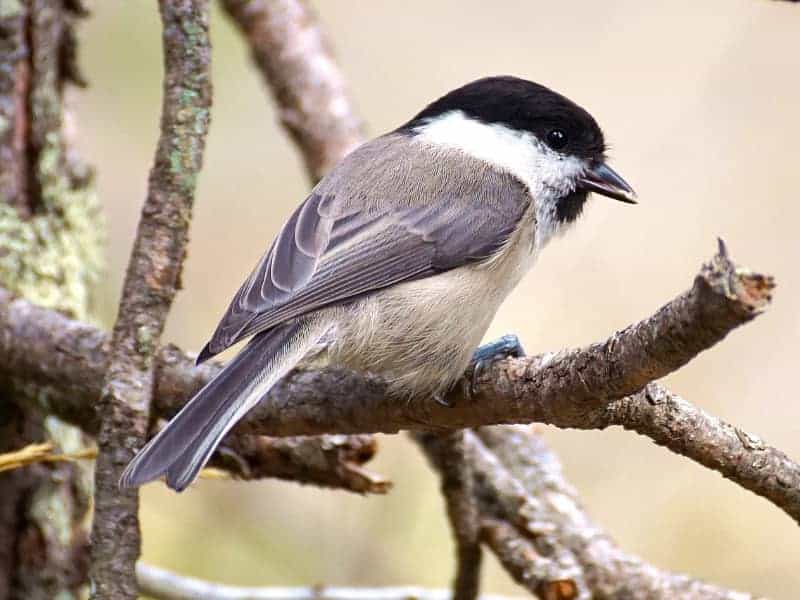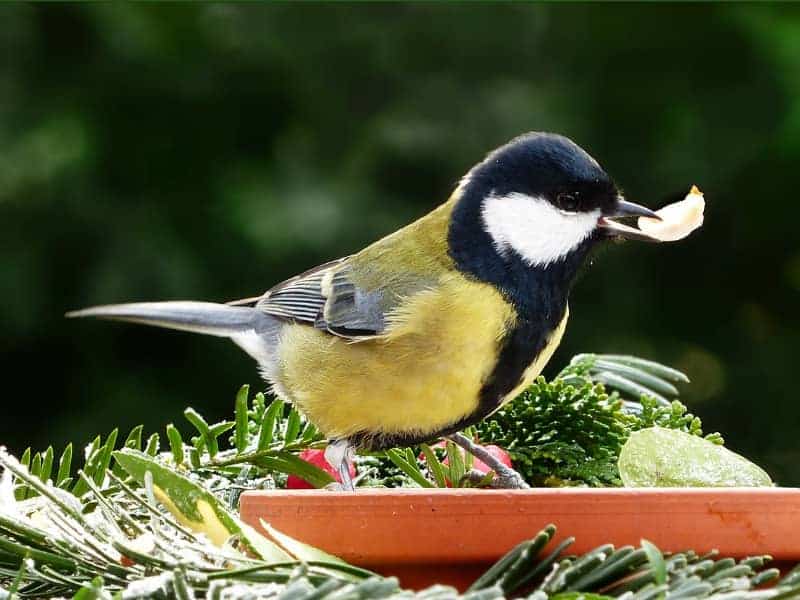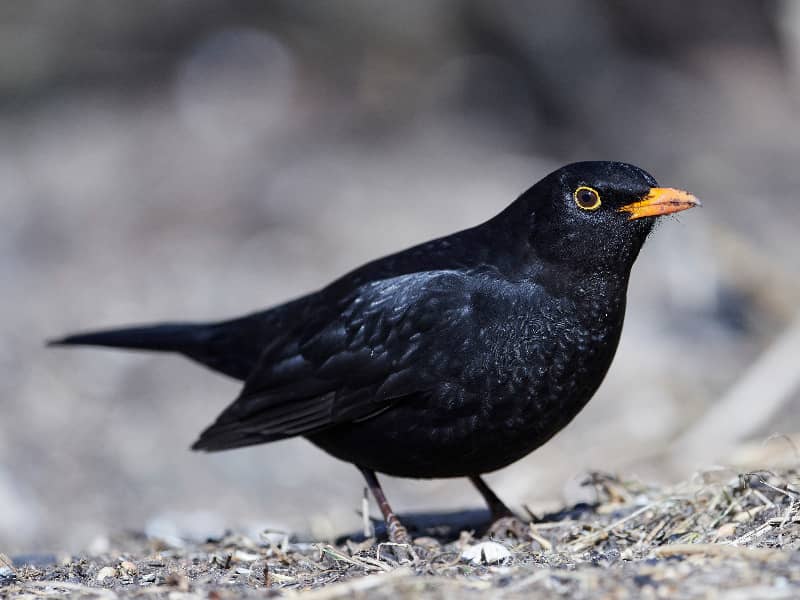
Marsh Tit
The marsh tit, also called the barnacle, belongs to the large family of tits. It is native to the whole of Europe, from the Atlantic Ocean to the Ural Mountains. Another habitat of the marsh tit is East Asia from Japan to East China and also in the eastern part of Russia this tit species can be found. From the Urals, to the habitat in the east is a 2000 km wide strip, where the tits do not live.
The marsh tit does not live in swampy areas as the name suggests, but prefers mixed forests with a high proportion of hardwood. Especially forests with a high proportion of old trees and a lot of deadwood are ideal for this tit species. Because in these trees there are enough caves for the animals to raise their offspring.
Marsh Tit Profile
| Size: | between 11 and 13 cm |
| Weight: | Approx. 12 g |
| Breeding season: | April till May |
| Age: | 4-6 years |
| Habitat: | Deciduous and mixed forests with old trees, parks and garden |
How to recognize the marsh tit
The marsh tit is colored brown on the back and wings, the belly is lighter and below the eyes the cheeks are kept white. The head from the eye area is colored black. It looks as if the marsh tit has a cap on its head. Below the beak is also a black spot that blends into the white breast. The marsh tit is slightly smaller than its relative, the great tit.
There are no sex-specific characteristics and thus female and male marsh tits are difficult to distinguish.
What do the eggs of the marsh tit look like?
The eggs of the marsh tit are whitish-gray and are covered with small brown-red spots. There are usually 7-9 eggs in a nest. The marsh tits pad their nest mainly with soft materials. This includes moss, but also feathers and hair from animals such as foxes, rabbits or if the tit lives in your garden from your dog or cat.
The nest of the marsh tit
Like almost all tit species, the marsh tit prefers caves in which to build its nest and breed. Marsh tits are monogamous and have partnerships that last for many years. These pairs begin looking for a suitable cave to set up their nest as early as fall, but no later than March. In the process, tasks are separated.
The male carefully selects the territory, while the female is responsible for finding the nesting site within the territory. The pairs of titmice gladly take over abandoned cavities of woodpeckers. They also like to use cavities in willow trees, these are often left by the willow tits and are well suited for laying the nest of the marsh tits.
The pair of marsh tits needs about a week for the nesting cavity to meet their requirements. During this time, they are almost continuously busy during daylight hours lining the nest according to their ideas.
- 🌧️ LONG-LASTING NESTING BOXES WITH "WEATHERPROOF GUARANTEE" Our nesting boxes made of the highest quality wood concrete with oval flight hole 30x45mm for, among others, tits, nuthatches and bats are made of renewable, sustainable and absolutely durable wood concrete in a small manufactory. Our used wood concrete offers the wild birds a good insulated temperature and humidity balance in the interior of the nest box.
- 🐦 COMPLETELY DELIVERED We deliver our wooden concrete boxes directly ready for assembly. The removable and replaceable front wall is mounted, as well as the suspension bracket is mounted. A matching aluminum nail for mounting on a wall, pole or tree is included in the cave.
- The nesting box with an oval entrance hole has been specially adapted for various tit species, nuthatches, wrens or even various field vole species. The nesting box made of wood concrete with a 30x45mm oval entrance hole- ideal for, among others, great tit, blue tit, fir tit and marsh tit, nuthatch, pied flycatcher and collared flycatcher, tree sparrow, as well as bats. Our products are subject to constant development of leading ornithologists.
- 🕊️ WOODEN CONCRETE - THE COMPOUND FOR THE BEST NEST BOXES: The combination of concrete and wood with the addition of sawdust and natural products is a guarantee for the right climate in the nest box. Our wood concrete is made exclusively with environmentally friendly products.
- 🌳 SUSTAINABLE: Our nesting boxes are manufactured in Germany and packed in wood wool in an environmentally friendly way. We consciously rely on energy-saving logistics and are happy to bear the additional costs.
Marsh tits, when do they breed?
Marsh tits breed in April and May. The eggs are incubated for about 12-15 days until the young birds hatch. For another 15-20 days, the young birds are fed in the nest and completely cared for by the parents. After this time, the first attempts at flight are made by the young birds. Within 2 to 5 days the young birds leave the nest and live outside from then on.
For a period of 10 to 14 days, the young marsh tits continue to be provided with food by their parents. Only then do they feed completely on their own and explore the environment on their own. In years with a good food supply, it is possible for the marsh tits to raise a second brood after the first successful rearing of the young.
Where do marsh tits live in winter?
Marsh tits are sedentary birds and therefore they live in their traditional territory all year round. They are extremely faithful to their habitat and move no more than 3-5 km from their territory, which is also their breeding area. The young birds usually settle near their parents. Thus, in winter it is not uncommon to observe a small flock of marsh tits active together.
What do marsh tits eat?
If you plan to attract marsh tits to your garden, then it is important for you to attract as many insects as possible. This is the basic prerequisite for marsh tits to establish a territory and raise their young there. So make your garden insect friendly, which means planting lots of native plants. Ideally, a garden pond, as well as hedges and a wild piece in the garden, where nettles and wild herbs can grow.
The marsh tit is not picky when it comes to food. So she eats all sorts of insects, such as:
- Bugs
- Flying
- Spiders
- Lice
- Worms
- Beetle
But plant food is not spurned either and is an important part of their diet. Therefore, berry bushes and wild meadow pieces, as well as wild flower beds are ideal for the marsh tits. Here is a list of the plant food:
- Grass and herb seeds
- Hemp seed
- Spinach seeds
- Beechnuts
- Elderberries
- Rowan berries
- Flowers seeds
- Pumpkin seeds
What can I feed a marsh tit?
Should you plan to feed a marsh tit, then as mentioned above, you should first create the conditions in your garden that the marsh tit can best feed itself. In a hard winter this looks different. Here it makes especially with a closed snow cover over several days are, if you offer the tits food.
- Artgerechtes Premiumfutter fürs Vogelhaus oder den Spender
- Bestens für alle Körner- und Weichfutterfresser geeignet
- Enthält über 10 % Erdnüsse sowie Pflanzenöl, Hafer & Mineralien
- Energie-Boost: kraftspendend dank hohem Ölgehalt
- Zur 365-Tage Fütterung Ihrer Wildvögel im heimischen Garten
Here you should pay attention to how cold it is. The colder, the more important that fat food is also offered. A fat food would be for example a tit dumpling, here fats are processed together with seeds to a ball and offered to the animals. This will provide them with a protein-rich and nutrient-rich diet, which they need in the winter to compensate for the increased energy consumption.
Here is a small list of what you can offer the tits:
- Sunflower seeds
- Oatmeal
- native seeds of all kinds
- Hemp seed
- dried berries and fruits
- Fat food like tit dumplings
Recognize the marsh tit by its song
We do not use written sounds here, and show you a video, where you can excellently recognize the chirping of the marsh tit. Close your eyes and listen only to the sounds and then we are sure that you will immediately recognize the song of the marsh tit. Should you hear these sounds outside, then in the rarest cases you have to look at trees. Mostly the marsh tits sit in hedges to chirp there.
Confusingly similar, the marsh tit and willow tit
The willow tit is rare in Germany. If you should see one, it is hard to distinguish it from a marsh tit. The characteristics how you can distinguish them are among others:
- The throat patch of the willow tit is slightly larger
- The wing coverts of the willow tit are not brown, but gray colored
- The black cap of the two titmice is not as dull black as that of the marsh titmice. But has a somewhat more intense black tone.
Author

-
Garden animal - A life with nature
Welcome to my animal blog! My name is Dirk and I am happy to take you on my journey through the fascinating world of animals and gardening.
Born 54 years ago, I have had an insatiable curiosity for the animal world around me since childhood. Although I have moved professionally in other industries, my true passion has always been animals and nature. It is remarkable how a small garden has become such an important part of my life.
Many of my fondest memories are associated with the animals that share our home. Whether it's the curious squirrels that scurry across the trees in the morning, the colorful variety of birds that visit our feeders, or the busy bees and butterflies that pollinate our flowers, every moment with them is invaluable to me.
This blog is my contribution to share my experiences, discoveries and insights with like-minded people. Here I will share stories of unforgettable encounters with animals, give tips on gardening and creating wildlife-friendly habitats, and take you on my journeys through nature.
Thank you so much for being here!
Cordial,
Dirk aka garden animal
Last posts
- 27. February 2024PetsVeganes Hundefutter – Grün und Gesund?
- 18. January 2024ChickensOregano für Hühner
- November 27, 2023HamsterDiurnal hamsters
- November 24, 2023HamsterHamster hammock
Letzte Aktualisierung am 2025-07-05 / Affiliate Links / Bilder von der Amazon Product Advertising API




